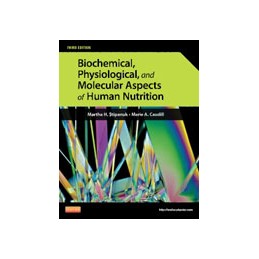- Reduced price

Order to parcel locker

easy pay


 Delivery policy
Delivery policy
Choose Paczkomat Inpost, Orlen Paczka, DHL, DPD or Poczta Polska. Click for more details
 Security policy
Security policy
Pay with a quick bank transfer, payment card or cash on delivery. Click for more details
 Return policy
Return policy
If you are a consumer, you can return the goods within 14 days. Click for more details
Covering advanced nutrition with a comprehensive, easy-to-understand approach, Biochemical, Physiological, and Molecular Aspects of Human Nutrition, 3rd Edition focuses on the biology of human nutrition at the molecular, cellular, tissue, and whole-body levels. It addresses nutrients by classification, and describes macronutrient function from digestion to metabolism. This edition includes the new MyPlate dietary guide and recommendations from the Dietary Guidelines for Americans 2010, plus coverage of the historical evolution of nutrition and information on a wide range of vitamins, minerals, and other food components. In Biochemical, Physiological, and Molecular Aspects of Human Nutrition, lead authors Martha H. Stipanuk and Marie A. Caudill are joined by a team of nutrition experts in providing clear, concise, coverage of advanced nutrition.
Data sheet
Unit I: Nutrients: Essential and Nonessential
1. Nutrients: History and Definitions
2. Nonessential Food Components with Health Benefits
3. Guidelines for Food and Nutrient Intake
Unit II: Structure and Properties of the Macronutrients
4. Structure, Nomenclature, and Properties of Carbohydrates
5. Structure and Properties of Proteins and Amino Acids
6. Lipid Structure, Nomenclature, and Chemical Properties
Unit III: Digestion and Absorption of the Macronutrients
7. Overview of Digestion and Absorption
8. Carbohydrate Digestion and Absorption
9. Digestion and Absorption of Protein
10. Digestion and Absorption of Lipids
11. Dietary Fiber
Unit IV: Metabolism of the Macronutrients
12. Carbohydrate Metabolism: Synthesis and Oxidation
13. Protein Synthesis and Degradation
14. Amino Acid Metabolism
15. Protein and Amino Acid Requirements
16. Metabolism of Fatty Acids, Acylglycerols, and Sphingolipids
17. Cholesterol and Lipoproteins: Synthesis, Transport, and Metabolism
18. Lipid Metabolism: Polyunsaturated Fatty Acids
19. Regulation of Fuel Utilization in Response to Food Intake
20. Regulation of Fuel Utilization in Response to Physical Activity
Unit V: Energy
21. Cellular and Whole-Animal Energetics
22. Control of Energy Balance
23. Disturbances of Energy Balance
Unit VI: The Vitamins
24. Niacin, Riboflavin and Thiamin
25. Folate, Choline, Folic Acid, Vitamin B12, and Vitamin B6
26. Biotin and Pantothenic Acid
27. Vitamin C
28. Vitamin K
29. Vitamin E
30. Vitamin A
31. Vitamin D
Unit VII: The Minerals and Water
32. Calcium and Phosphorus
33. Magnesium
34. Sodium, Chloride, and Potassium
35. Body Fluids and Water Balance
36. Iron
37. Zinc, Copper, and Manganese
38. Iodine
39. Selenium
40. Fluoride
41. Molybdenum and Beneficial Bioactive Trace Elements
Reference: 30810
Author: Martha H. Stipanuk
Reference: 30811
Author: Martha H. Stipanuk
